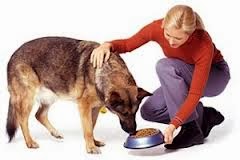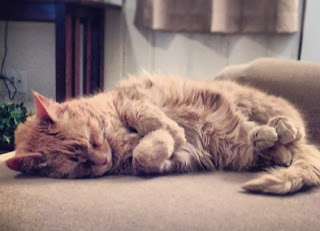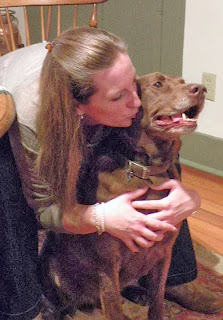Hospice Care is an Active Process
 Many times I have seen pets left to slowly deteriorate and die, without the benefit of hospice care. These aren’t neglected or abused pets. Their owners are not cruel, heartless people. These pets are loved, but their people have not been educated in the art of pet hospice care. Hospice care is not simply watching your pet’s condition worsen, standing by while all of the body systems shut down, one by one. No, quite the opposite is true. Hospice care is an active process in which the pet owner intervenes – sometimes in subtle ways, sometimes in quite dramatic ways – to ensure that the pet’s last months, weeks, and days are comfortable and dignified.
Many times I have seen pets left to slowly deteriorate and die, without the benefit of hospice care. These aren’t neglected or abused pets. Their owners are not cruel, heartless people. These pets are loved, but their people have not been educated in the art of pet hospice care. Hospice care is not simply watching your pet’s condition worsen, standing by while all of the body systems shut down, one by one. No, quite the opposite is true. Hospice care is an active process in which the pet owner intervenes – sometimes in subtle ways, sometimes in quite dramatic ways – to ensure that the pet’s last months, weeks, and days are comfortable and dignified.
Dr. Zaring’s Fair Four
It is my belief that if one wishes to keep a terminally ill pet or a pet of advanced age (particularly a pet of advanced age that has one or more chronic conditions) alive, then that person should ensure that the pet has decent mobility, adequate nutrition, and is free of infection and pain. This is fair to the pet. If these basic needs cannot be met, then the pet does not have a good quality of life, and it is no longer fair to keep the pet alive. Sadly, it is at that point that I believe a pet owner should consider humane euthanasia.
 1. Mobility is Essential
1. Mobility is Essential
While an old dog or cat is not going to hop around like he did in younger days, he still needs to be able to walk. In most cases, reduced mobility is due to one of two problems: weakness or pain. An example of weakness leading to poor mobility is an old cat with kidney failure. Kidney failure causes anemia – reduced production of oxygen-carrying red blood cells. Anemia causes fatigue and weakness. An old kitty in the advanced stages of kidney failure may need help standing, encouragement to walk, and special food & medications to increase strength. An example of pain affecting movement is an old dog with advanced arthritis. Painful joints make it too hard to move around, and the less the dog moves, the more stiff and painful his joints become.
Lack of mobility is a great source of anxiety for animals, and they can become depressed. Your pet needs to be able to lie down in comfort, get up (even if it is with assistance), and walk at least a few steps. Lying in the same position for long periods of time will make your pet stiff, further inhibiting his ability to move. Also, lack of mobility predisposes animals to pneumonia and painful bed sores (infected skin ulcers).
 2. Provide Adequate Nutrition
2. Provide Adequate Nutrition
Old pets often do not eat well. Many factors can contribute to poor appetites in older pets. Some have bad teeth, others are in too much pain to eat, some have upset stomachs, and many old pets are just too exhausted to make the effort to eat. You may need to provide your elderly pet with elevated food and water dishes, so he doesn’t have to bend over to reach them. An old pet may need to eat canned food, since it is easier to chew and swallow. Food may have to be extra flavorful and served warm. You may have to hand feed your dog or cat, encouraging her to eat each bite. In the last stages of hospice care, you may have to feed your pet with a syringe or consider having your veterinarian place a feeding tube. (Feeding tubes are not always the best option for the pet – but that’s a discussion for another blog.)
3. Treat & Prevent Infections
Infections are more common in old animals than in young animals. Senior pets are prone to skin infections, urinary tract infections, and tooth infections. Infections cause pain, and the infection can enter the blood stream and damage critical organs. It is very important to have your veterinarian examine your senior pet closely, diagnose any active infections, and treat the infections appropriately.
Part of your responsibility as your pet’s hospice care provider is to take steps to prevent infections. Keeping your pet clean and dry is your best defense against infection. Check your pet’s bedding several times a day for moisture. Moist bedding must be replaced with dry bedding. Old dogs and cats often cannot reach their bottoms to clean themselves after going to the bathroom. You will need to use baby wipes or a damp washcloth to clean your pet’s anal area. If you have a girl dog or cat, you will need to make sure her vulva stays clean, so she doesn’t develop a bladder infection. Our senior pets need help with their coats too. Regular brushing will help keep the hair from matting.
4. Alleviate Pain
Our pets are people pleasers. They want so badly for us to think that all is well, that they will hide their pain from us. I could write an entire blog about recognizing pain in dogs and cats. It is difficult. As I’m typing this, I hear echos of pet owners telling me, “He doesn’t seem to be in pain,” and “She doesn’t cry out or scream, so she must not be hurting.” Trust me, you don’t want to know the horrific level of pain that is required to make a dog or cat scream. Here is my rule of thumb: If a condition is painful to a person, it is painful to a pet. Crippling arthritis = painful. Ulcerated skin tumors = painful. Severe tooth decay = painful. Cancer = painful. Don’t let your stoic pet suffer quietly with a painful ailment. Ask your vet to assess your pet for pain and prescribe an appropriate pain management program for your pet.
My sunshine doesn’t come from the skies,
It comes from the love in my dog’s eyes.
~Unknown
 Advanced & Complimentary Care may be an Option for Your Pet
Advanced & Complimentary Care may be an Option for Your Pet
Alright, I’ve covered the “Fair Four.” That is, my four essential aspects of hospice care: maintain mobility, treat infection, keep your pet eating, and control pain. I believe that these are the four areas that must be managed if you are choosing to keep your very old or terminally ill pet alive. (The other choice is humane euthanasia – definitely a topic for a whole other blog.)
Where to take hospice care beyond the “Fair Four” is an unique, personal decision that you will have to make. How a person approaches pet hospice care depends on many factors, including the person’s view of animals, the person’s view of pet ownership, the bond with the animal, the presence or absence of children in the household, the pet’s temperament, ethical considerations, religious beliefs, and financial constraints. Your veterinarian’s job is to work with you to formulate a hospice plan that meets the basic requirements I outlined earlier in this blog AND that meets your personal expectations.
 There is nothing wrong with doing basic hospice care. It has been my experience that most pet owners want to maintain the “Fair Four” as long as they can, and then they want to have their pet peacefully euthanized in the comfort of the home. This is perfectly acceptable.
There is nothing wrong with doing basic hospice care. It has been my experience that most pet owners want to maintain the “Fair Four” as long as they can, and then they want to have their pet peacefully euthanized in the comfort of the home. This is perfectly acceptable.
Some people have the desire and the ability to provide advanced hospice care for their pets, and they have pets who are good candidates for advanced hospice care. In those cases, I am happy to oblige. Advanced hospice care can take many forms. It may involve injection of fluids under the skin to maintain hydration, combinations of pain medications, slings or carts to improve mobility, prescription diets, feeding tubes, cutting-edge treatments, physical therapy, short hospital stays during flare ups, and even referral to veterinary specialists. Also, some pets will benefit for complimentary veterinary care, such as vitamins, herbs, massage, acupuncture and chiropractic adjustments. If you think that you and your pet are candidates for advanced hospice care, talk with your veterinarian. He or she can work with you to develop a comprehensive plan for your pet.
 Curbside Care & Dr. Zaring are here to help.
Curbside Care & Dr. Zaring are here to help.
We all love our pets and wish they could live with us forever. However, we also know all too well that our dogs and cats are merely visitors on our life journeys. The time will come when a beloved pet needs your help in his or her final days. It is your duty to return the great love your pet has given you by ensuring that the final days are filled with comfort, love and peace.
If you need help determining your pet’s quality of life, formulating a hospice care plan, or planning for your pet’s end of life care, including in-home euthanasia, please call us at (317) 771-1952 or email us at curbsidecare@mail.com.